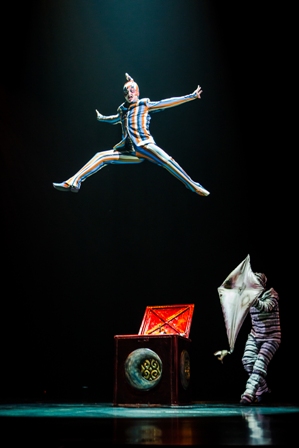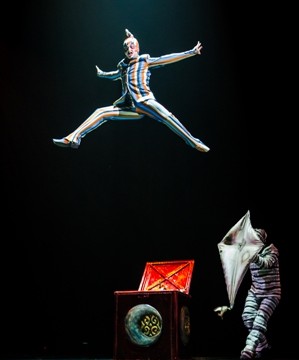By Jeff Maisey
With Kooza, which sets up under the big tent for a full month in Virginia Beach, Cirque Du Soleil returns to its roots: acrobatics and clowning.
I recently caught up with Colin Heath to learn more from a clown’s perspective.
Acrobatics and clowning are core ingredients of Cirque Du Soleil. Can you elaborate on these essential elements?
Yeah. The guy who wrote and directed this show (David Shiner) is a clown. So already he had a sensibility to the clowns.
There was a string of shows that Cirque Du Soleil produced that were brilliant in their way but they sort of had an otherworldly quality to them. I think he wanted to bring it back to a more traditional circus style to connect more with the people on a human level. I think it does that. The acrobatics in the show are thrilling and dangerous. There are points where the entire audience gasps all at once. I love those moments when you’re really on the edge of your seat.
The acrobatics are very controlled. Our job as the clowns is to go in and mess it all up – bring a moment of chaos to it. And, basically, make people laugh. They have fear; they have wonder, laughter.
Where you inspired by clowns growing up?
Yes. I grew up in Victoria, BC (British Columbia). The clowns I was exposed to there were silent films and Charlie Chaplin. Like every North American kid I watch a lot of TV. We had the Shriner Circus and smaller circuses with American style clowning with the red nose and rainbow wig kind of thing. They were fine but it wasn’t what I wanted to do.
When I first saw Cirque Du Soleil in 1986 I was totally energized and wanted to do that. It was clowning on a different level. It seemed like it really fit into the show. It wasn’t just the clowns coming in and sweeping up while the next act is preparing. It was part of the story.
With a show like Kooza and Ringling Brothers’ announcement that they’re phasing out elephants, does this signal perhaps that live animals should never have been part of a circus? Was Cirque Du Soleil way ahead in its thinking?
Well, yeah, that’s my own personal opinion. I’m against the use of animals in circuses. So already I’m biased toward Cirque Du Soleil in that aspect.
I think the reason there aren’t animals in the show has more to do with controlling the theatricality of the show. Animals bring a wild element to it that you can’t really control. They’re hard to look after. They run around the stage.
Our show is high tech. It’s more like a Broadway show in that respect.
But, yeah, you might be right that Cirque was ahead of its time. I remember when it first came out it was something new. I hadn’t seen anything like it before – a theatrical circus.
One of the characters in Kooza is the Obnoxious Tourist, which is interesting because Virginia Beach is a tourist destination. Is there some irony in this?
The character doesn’t change from town to town. He’s just an obnoxious guy who gets in people’s way; throws popcorn around; gives kids money to buy beer for him. He’s loud. He gets the show started, basically. He says, “C’mon, c’mon. What is this Cirque du So Late?”
From your perspective, as a performer, do you prefer to be in one location for a full month, or do you like the shorter duration tour stops?
Well, sure. You get to set up your stuff. Maybe you get to find a gym you like. It is nice to get to settle down for at least a little while, even if it’s a month. The longest we’ve done is six months. That was in Tokyo. There’s so much to do in Tokyo it was a blessing. The beach I don’t know at all so I’m looking forward to discovering it.
Do you notice a difference between audiences from Japan and the US?
Absolutely. Even between cities in the US. We do our opening night and we get a sense of how the audience responds. We adjust our comedy according to that. It usually takes four or five days before we really figure out what makes them laugh. Somebody will laugh at something in Texas that they don’t get at all in Munich. A lot of our stuff is quite bold and dirty sometimes so we’re looking for where the line of propriety is. Where is the edge, you know? We just stick our foot over it. That’s our goal: to push the envelope a little bit. I find that audiences in America really eat it up if you get rude and obnoxious. They’re not scared of sexual innuendo. They laugh at it. That challenges us to be a bit more wild.
What is your favorite routine of your performance in Kooza?
I actually love the stuff that’s just improvising in a crowd. Before the show actually starts we’re wandering around and playing with the audience. There’s no pressure. We can do what we want. We can be one-on-one with the people. That’s fun. The clown’s job along with creating chaos is to connect with the audience. We’re talking to people, bringing them on stage. I like that.
Kooza
Presented by Cirque Du Soleil
July 16 through August 16
Virginia Beach Convention Center





